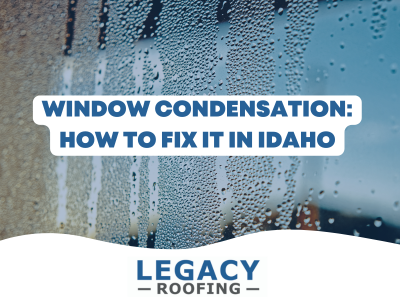Are you dealing with some window condensation issues?
Most homeowners are told that foggy windows mean “just wipe them down,” but condensation inside the glass indicates a broken seal. Idaho temperature swings can stress window seals over time, especially in older homes around Boise, Meridian, and Nampa. That haze isn’t just visual. It reduces insulation, comfort, and energy savings. The question is not if it should be fixed, but how.
We’ll walk you through repair options, replacement indicators, and provide clear next steps you can take with confidence.
What Causes Window Condensation and Fogging in Idaho Homes?
Boise isn’t Savannah, aka, we don’t have humidity like they do. However, foggy windows typically result from the interaction of air, temperature, and seals—Idaho’s climate swings dramatically between cold mornings and warm afternoons, which stresses window systems.
Here are the six most common causes:
- High indoor humidity: Every day, moisture from showers, cooking, and breathing collects on cold glass surfaces.
- Failed double-pane seals: Once the seal breaks, outside air slips between panes and traps moisture.
- Poor ventilation: Stagnant indoor air keeps humidity from escaping, especially in tightly sealed homes.
- Inefficient windows: Older single-pane or thin double-pane windows cool quickly, making condensation more likely.
- Big temperature swings: Idaho’s day-night shifts cause glass to expand and contract, weakening seals over time.
- Blocked weep holes or drainage paths: Moisture stays trapped instead of draining outside.
How Does High Indoor Humidity Lead to Window Condensation?

Warm indoor air holds moisture. When that warm air touches a cold window surface, the temperature drops, and the air can’t hold the same amount of moisture anymore. That excess moisture settles as droplets on the glass. If the humidity remains high in the long term, condensation becomes more frequent and can drip into sills, trim, and drywall. Reducing indoor moisture through proper ventilation and airflow is more effective in solving this issue than wiping the glass daily.
Why Do Failed Double Pane Window Seals Cause Moisture Between Panes?
When a double-pane seal fails, the insulated air space between the glass is no longer sealed. That space becomes vulnerable to outside humidity.
Here are five reasons seals fail:
- Age and wear: Sealants naturally dry, shrink, and lose bonding strength.
- Thermal expansion: Idaho temperature swings cause constant glass movement that stresses the perimeter seal.
- UV exposure: Sunlight breaks down sealants and spacer adhesives over time.
- Poor original installation: If the window was set out of square or with stressed edges, seal life shortens.
- Trapped moisture during manufacturing: Imperfect factory drying sometimes leads to early internal condensation later.
Once the seal is compromised, there is no airtight barrier left to prevent moisture from entering.
How Do Temperature Differences Affect Window Fogging in Idaho?
Cold outside air cools the outer glass, while heated indoor air warms the interior side. When the inner surface gets cold enough, airborne moisture condenses. Idaho homes see this most often in winter mornings and during sudden seasonal shifts.
The bigger the difference between indoor and outdoor temperatures, the more likely fogging occurs. Improving insulation, adding ventilation, or upgrading to better insulated window units helps even out those temperature differences and reduces condensation.
How Can You Fix Foggy Windows and Moisture Between Panes in Idaho?
Fixing foggy windows starts with identifying whether the seal is salvageable or if the insulated glass unit has already failed.
Here is a simple step-by-step approach that keeps decision-making clear:
- Inspect the window seal and frame. Check for cracked caulking, brittle rubber seals, or gaps at the sash. If the seal is broken, wiping or cleaning will never remove the fog because the moisture is inside the glass cavity.
- Determine if the window is still structurally sound If the frame is solid and only the insulated glass is compromised, you may replace just the glass panel. This costs less than replacing the entire window and preserves your existing trim and framing.
- Consider de-fogging services carefully. Some companies drill micro-holes to vent moisture and install a drying agent. Results vary and may only offer short-term improvement. In Idaho climates, where temperatures fluctuate daily between heat and cold, fog commonly returns if the seal is not renewed.
- Replace the insulated glass unit (IGU) if the seal has fully failed. This restores clarity and insulation without replacing the entire window frame. It is often the most cost-effective long-term solution when frames are in good condition.
- Replace the entire window when its efficiency or structural integrity is compromised. If the frame is warped, drafty, rotten, or original to the home, investing in a full replacement saves more over time. New windows provide better insulation, improved comfort, and lower energy costs throughout every season.
How Can Idaho Homeowners Prevent Window Condensation and Fogging?
Want to know how to prevent condensation? Get magnificent windows! All jokes aside, here is what you will have to do!
Preventing window condensation in Idaho requires controlling indoor humidity, improving ventilation, and selecting appropriate window upgrades that raise surface temperatures and reduce dew-point crossings.
Seasonal habits such as running bathroom and kitchen exhaust during winter cooking and showering, using portable dehumidifiers in basements, and ensuring dryer vents exhaust outdoors substantially lower the risk of condensation (but remember, condensation is also a sign of other window issues).
Maintenance, such as checking seals, repairing minor frame damage early, and considering energy-efficient IGUs with low-e coatings, reduces the likelihood of recurring moisture problems. These prevention steps work together to protect clarity, conserve energy, and extend the life of window assemblies.
How Do Energy-Efficient Window Upgrades Help Prevent Moisture Issues?
Energy-efficient windows reduce condensation by controlling temperature and airflow at the glass surface. When the inside layer of the window stays warmer, indoor air is less likely to cool rapidly and release moisture. That means fewer foggy mornings, fewer wet sills, and fewer hidden mold or trim problems.
Modern insulated glass units (IGUs) utilize argon or krypton gas fills, low-emissivity (low-e) coatings, and thermal spacers to reduce heat loss. These features keep the inner pane closer to room temperature, even on cold Boise mornings that drop below freezing. The warmer the surface inside stays, the lower the chance that indoor humidity will hit its dew point and condense.
Beyond comfort, the upgrade also helps your heating system. Stable indoor temperatures reduce furnace cycling, resulting in less energy waste and more consistent comfort during winter.
A quick way to see the benefits:
- Warmer interior glass surface = less condensation.
- Better insulation = fewer drafts and cold zones.
- Improved durability = seals last longer and resist seasonal stress.
What Are the Typical Costs for Foggy Window Repair and Replacement in Idaho?
Costs depend on window size, frame condition, and whether the glass or the entire unit needs replacement. Here is a clear comparison to help set expectations:
| Service Type | What It Involves | Typical Cost (Per Window) | When It Makes Sense |
|---|---|---|---|
| Glass-Only Replacement (New IGU) | Remove and replace the window and frame as one unit | Replace the insulated glass unit, keep the existing frame | Frame is solid and seal failure is the only issue |
| Full Window Replacement | Remove and replace window and frame as one unit | $600–$1,500+ | Frame is damaged, drafty, outdated, or low-efficiency |
| Defogging / Moisture Removal Service | Drill valve holes and clear condensation temporarily | $75–$200 | Short-term clarity is needed, but insulation benefit is not restored |
| Frame Repair (wood rot, warping) | Repair or rebuild frame sections before resetting glass | $200–$800 | Damage is localized and window is still worth keeping |
Note: Costs vary based on window size, double vs triple pane, accessibility, and local material availability.
Is Repairing Foggy Windows More Cost-Effective Than Replacement?

Both repair and replacement can be cost-effective, depending on the situation. The key is matching the solution to the window’s age, frame condition, and insulation performance.
Repair makes sense when:
- The window frame remains sturdy, without rot, warping, or drafts.
- Only the insulated glass unit has failed.
- You want improved clarity and insulation without full replacement cost.
Replacement makes sense when:
- Windows are older and already struggle with drafts or heat loss.
- There is noticeable frame damage, swelling, or mold.
- You want long-term energy savings and updated performance.
Think of it this way: Repair saves money now. Replacement saves money over time.
Why Choose a Local Contractor to Replace or Repair Windows in Idaho?
Local conditions shape how well your windows perform. A contractor who works in the Treasure Valley daily understands what holds up and what fails.
1. Knowledge of Idaho Climate Patterns: Boise and the surrounding areas experience quick temperature swings and low winter humidity. Local pros know which window materials and sealants best handle expansion, contraction, and cold-air drafts. That means fewer seal failures and better long-term clarity.
2. Familiarity with Home Styles and Frame Types: Homes in Meridian, Nampa, Eagle, and Boise vary widely in age and construction style. A local contractor is familiar with the different framing methods used in homes and the original installation of windows. This reduces surprises during installation and ensures a snug, efficient fit.
3. Faster Support and Real Accountability: Local companies rely on reputation within the community. If something needs adjustment later, you are not dealing with a national call center. You get fast service, real follow-up, and clear communication. Long-term relationships lead to better workmanship and better warranties.
Verdict on Foggy Windows
There is a saying that if you have foggy vision you could be missing some signs. Luckily, when it comes to your home’s windows, foggy is THE sign. It is the sign that condensation is your window’s way of asking for help. We know how to determine when a simple glass swap is effective and when a full upgrade is the smarter investment.
Let’s take a look and choose the right path for your home. Want clarity in both your windows and your decisions? Let Legacy Roofing help you with new windows! Be sure to read our latest guide on window styles and sizing here!
If you need help, always reach out below!


 How to Choose the Right Window Size and Style for Boise Houses
How to Choose the Right Window Size and Style for Boise Houses